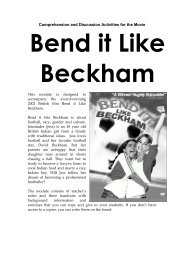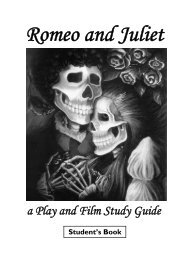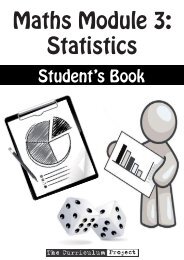General English Pre-Intermediate Modules 1-4 Teacher's Guide (2.1 ...
General English Pre-Intermediate Modules 1-4 Teacher's Guide (2.1 ...
General English Pre-Intermediate Modules 1-4 Teacher's Guide (2.1 ...
Create successful ePaper yourself
Turn your PDF publications into a flip-book with our unique Google optimized e-Paper software.
B. Students write answers to the questions, using an adverb of frequency in each answer. Write one or<br />
two examples on the board, e.g.<br />
1. I don’t often travel by bicycle.<br />
2. I never travel by boat.<br />
They can refer to the Language Reference if necessary.<br />
3.2 On Saturdays<br />
A. Students think about their normal activities on Saturdays. How often do they do the listed activities<br />
They write an adverb next to each, e.g.<br />
- visit friends often<br />
B. Put students into pairs or groups. They should discuss their Saturday activities, both the ones in A<br />
and other ones they can think of. If you like, ask a few of them to tell the class about their partner or<br />
group.<br />
4. wh- Questions<br />
This section looks at wh- questions in the present simple.<br />
• meanings of wh- question words<br />
• how to form questions in the present simple<br />
4.1 <strong>General</strong> knowledge<br />
A. Students work in pairs, and choose the best answers to the questions.<br />
They should use a dictionary to check any new words.<br />
Elicit answers from the students, and check if the class agrees before you give the correct answers.<br />
Answers:<br />
1. grass 2. Italy 3. January 4. bread and cakes 5. the North Pole<br />
6. to wake up 7. watch movies 8. eggs and water<br />
B. Students work in pairs. Student A looks at this page; Student B looks at page 66.<br />
Students ask and answer the questions, and tell the other pair which ones they got right. (The answers<br />
are upside down in a box under the questions.)<br />
C. In their pairs, students write two general knowledge questions, each with one right and two wrong<br />
possible answers. They should know which is the correct answer.<br />
Each student in turn reads one question to the class, including the possible answers, and students<br />
write down their answers.<br />
After everyone has read their questions, check the answers. Who got the most right<br />
If you have a very large class, you can do this in groups instead: pairs make two questions, then get<br />
into groups of eight or more and ask the questions.<br />
Module 1<br />
7


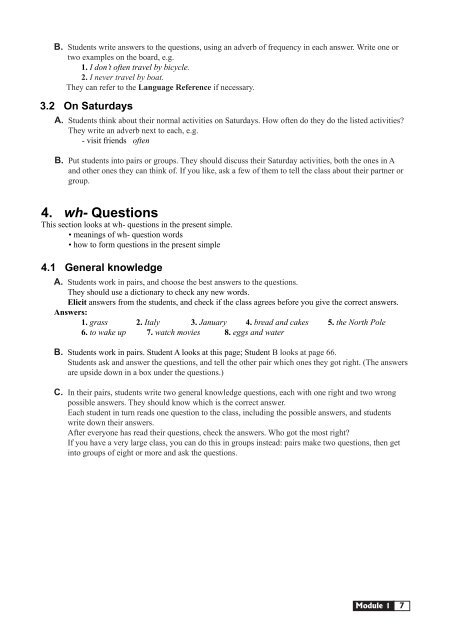
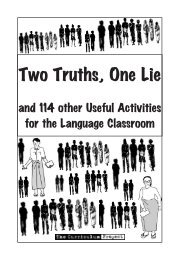
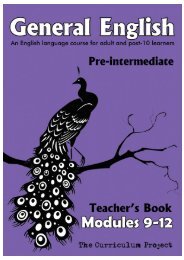


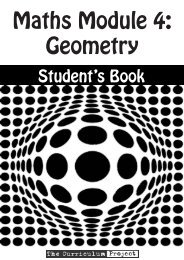

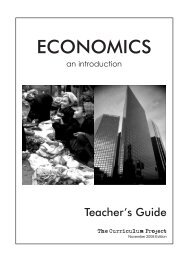
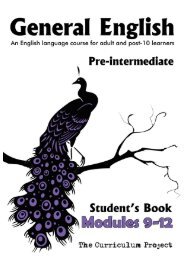

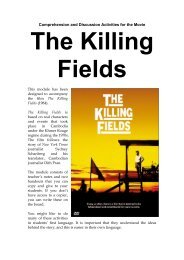
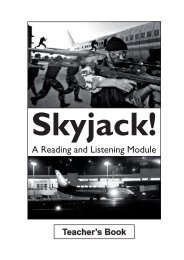
![[Eng] Nov 2012 DRAFT - The Curriculum Project](https://img.yumpu.com/45590859/1/184x260/eng-nov-2012-draft-the-curriculum-project.jpg?quality=85)
